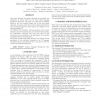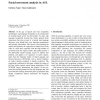INTERSPEECH
2010
14 years 3 months ago
2010
One of the difficulties in Language Recognition is the variability of the speech signal due to speakers and channels. If channel mismatch is too big and when different categories ...
ICASSP
2010
IEEE
14 years 5 months ago
2010
IEEE
This paper describes the system submitted by Loquendo and Politecnico di Torino (LPT) for the 2009 NIST Language Recognition Evaluation. The system is a combination of classifiers...
UAIS
2008
14 years 8 months ago
2008
In the age of speech and voice recognition technologies, sign language recognition is an essential part of ensuring equal access for deaf people. To date, sign language recognition...
UAIS
2008
14 years 8 months ago
2008
Abstract Research in the field of sign language recognition has made significant advances in recent years. The present achievements provide the basis for future applications with t...
TASLP
2008
14 years 8 months ago
2008
The performance of spoken language recognition system is typically formulated to reflect the detection cost and the strategic decision points along the detection-error-tradeoff cur...
LREC
2010
14 years 9 months ago
2010
Automatic language recognition on spontaneous speech has experienced a rapid development in the last few years. This development has been in part due to the competitive technologi...
LREC
2010
14 years 9 months ago
2010
A speech database, named KALAKA, was created to support the Albayzin 2008 Evaluation of Language Recognition Systems, organized by the Spanish Network on Speech Technologies from ...
ICASSP
2008
IEEE
15 years 2 months ago
2008
IEEE
In this paper we describe the application of a feature-space transform based on constrained maximum likelihood linear regression for unsupervised compensation of channel and speak...
ICASSP
2008
IEEE
15 years 2 months ago
2008
IEEE
One commonly used approach for language recognition is to convert the input speech into a sequence of tokens such as words or phones and then to use these token sequences to deter...
ICASSP
2008
IEEE
15 years 2 months ago
2008
IEEE
We propose novel approaches for optimizing the detection performance in spoken language recognition. Two objective functions are designed to directly relate model parameters to tw...





